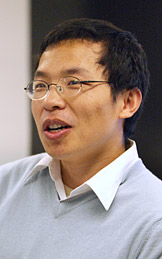Dr. Yi Qi
The PhysOrg article Energy-harvesting rubber sheets could power pacemakers, mobile phones said
“Power-generating rubber films developed by Princeton University engineers could harness natural body movements such as breathing and walking to power pacemakers, mobile phones and other electronic devices.The material, composed of ceramic nanoribbons embedded onto silicone rubber sheets, generates electricity when flexed and is highly efficient at converting mechanical energy to electrical energy. Shoes made of the material may one day harvest the pounding of walking and running to power mobile electrical devices. Placed against the lungs, sheets of the material could use breathing motions to power pacemakers, obviating the current need for surgical replacement of the batteries which power the devices.
In addition to generating electricity when it is flexed, the opposite is true: the material flexes when electrical current is applied to it. This opens the door to other kinds of applications, such as use for microsurgical devices.
‘The beauty of this is that it’s scalable,’ said Yi Qi. ‘As we get better at making these chips, we’ll be able to make larger and larger sheets of them that will harvest more energy.’”
Yi Qi, Ph.D. is Research Associate, Mechanical and Aerospace Engineering, Princeton University.
Yi’s research interests are magnetic materials, electronic materials, thin films, coatings, vacuum processes, PLD, sputtering, CVD, E-beam evaporation, lithography, ion milling, process development, characterization, TEM, SEM, XRD, materials engineering, and scanning microscopy.
He coauthored Direct observation of the ice rule in an artificial kagome spin ice, Electron Thermal Microscopy, Local Dielectric Measurements of BaTiO3-CoFe2O4 Nano-composites Through Microwave Microscopy, and In-Situ Operation of Nanoelectronic Devices.
Yi earned his Bachelor degree in Business Management and Materials Science (double major) at Tsinghua University, China in 1999, his Masters degree in Materials Science at Tsinghua University, China in 2002, and his Ph.D. in Materials Science with the dissertation Artificial Kagome Spin Ice at the University of Maryland College Park, USA in 2008.
